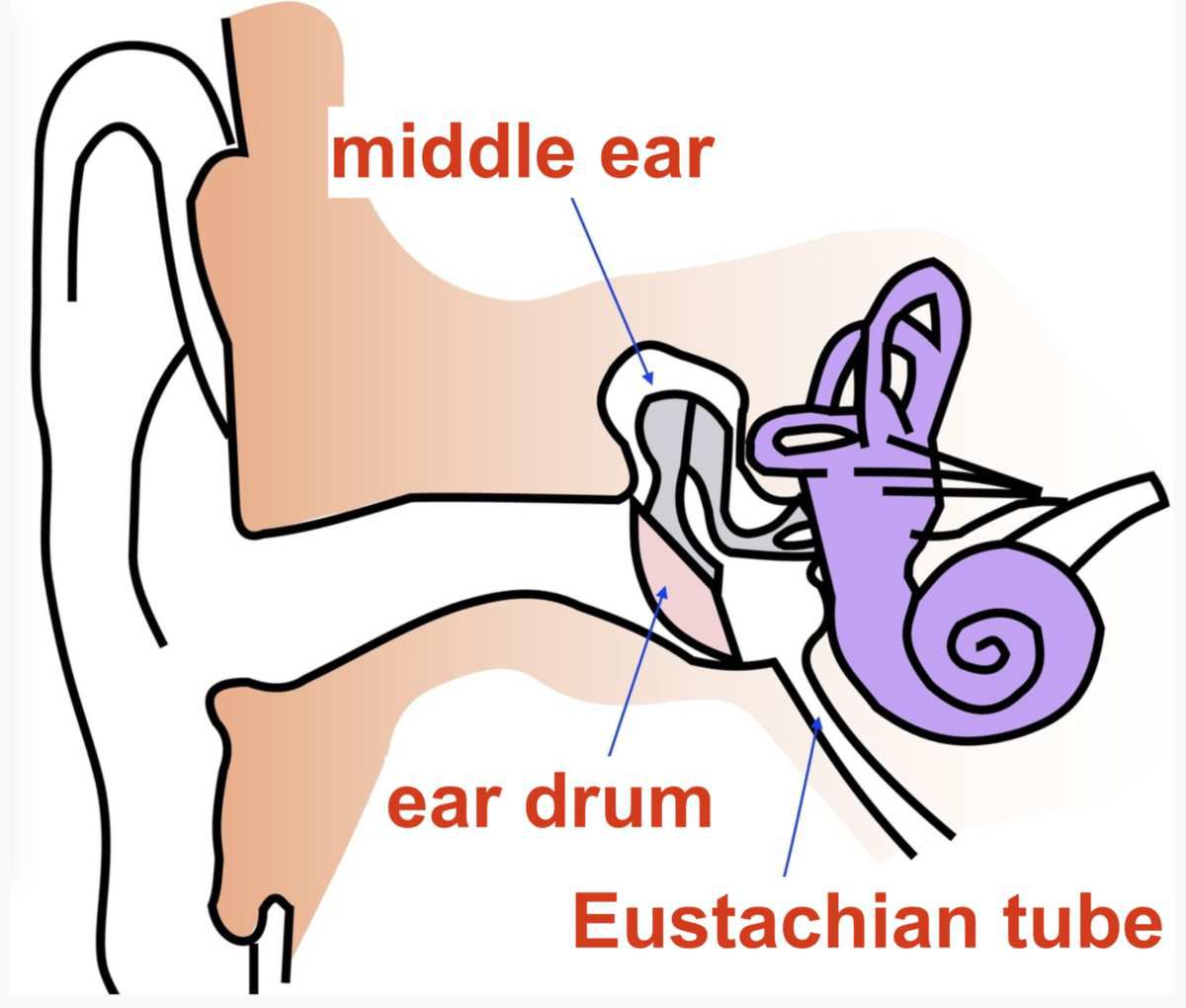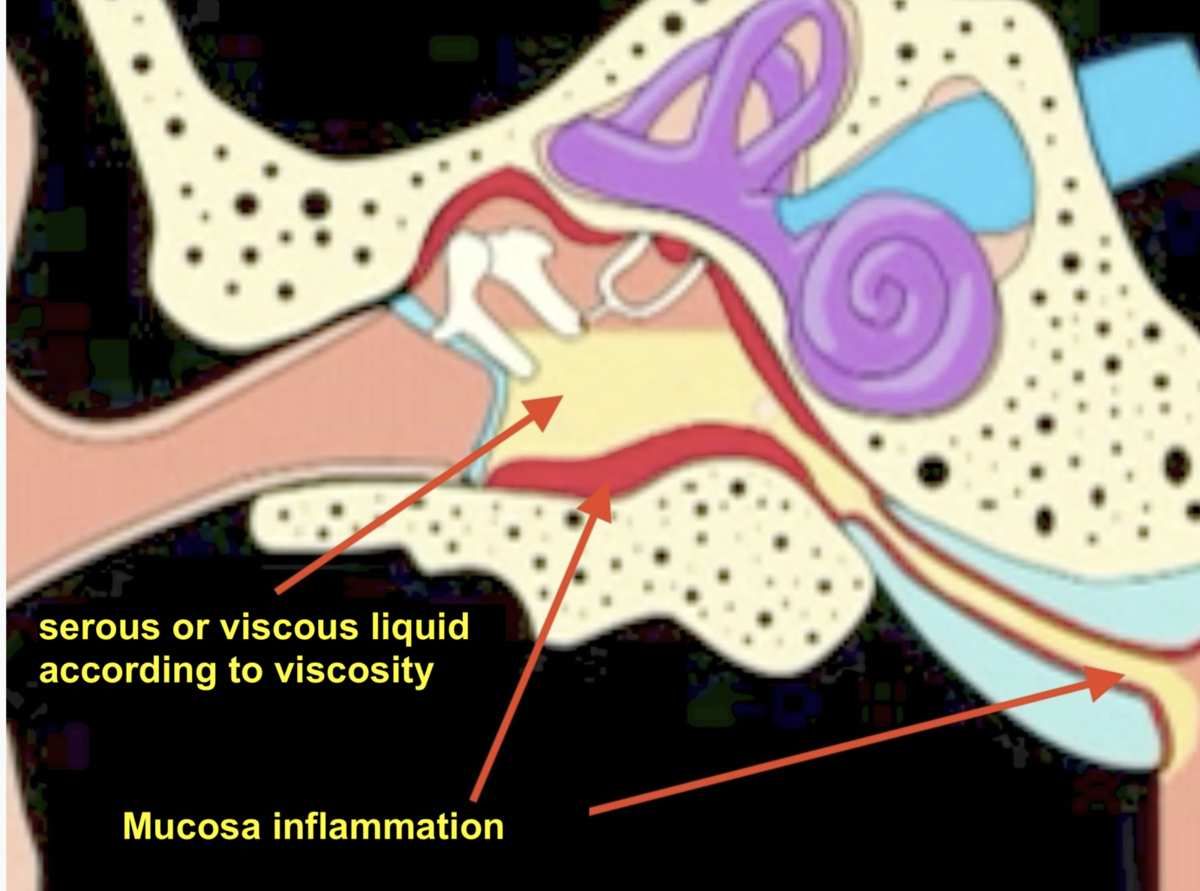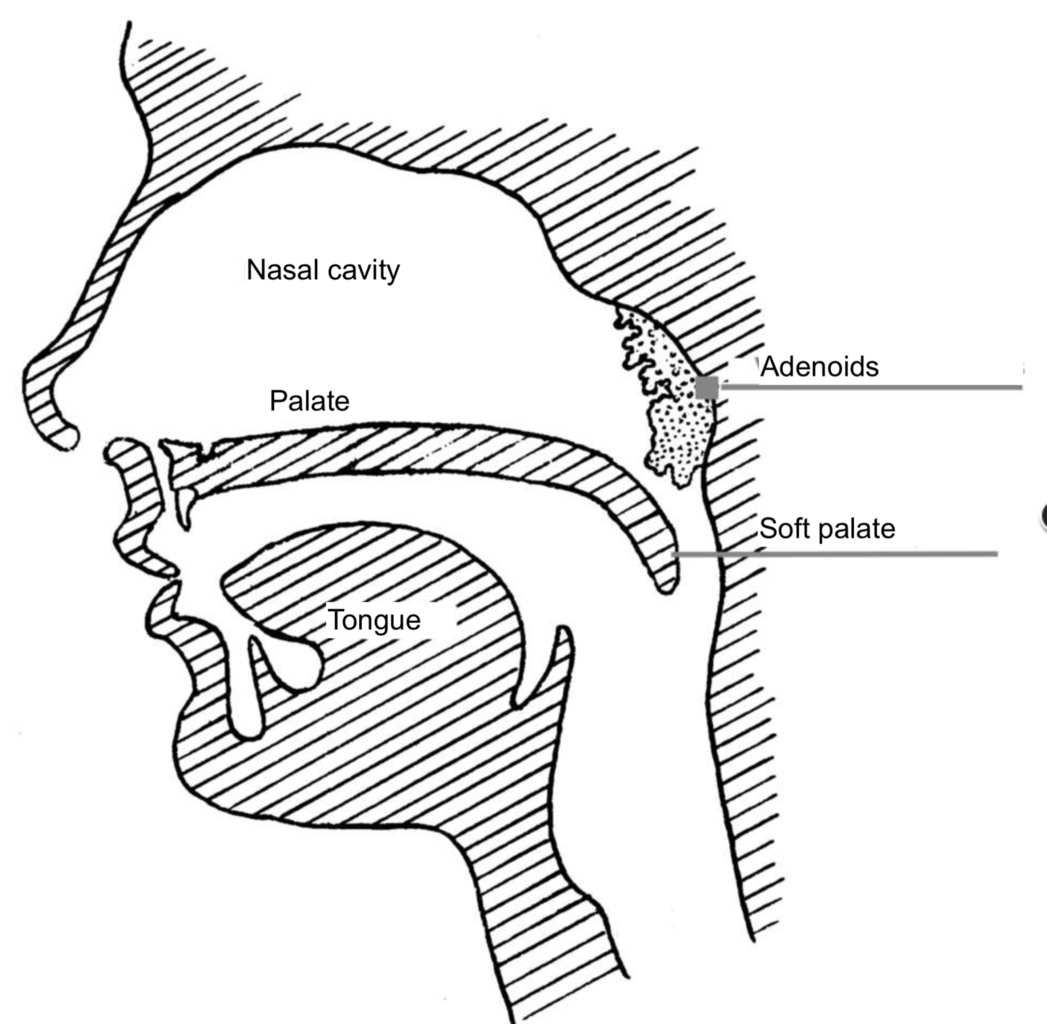chronic serous otitis, chronic otitis mucoid, tubotympanic
The ear is composed of 3 compartments, from outside to inside
1. The outer ear, which includes the auricle and the external auditory canal
2. The middle ear, separated from the outer ear by the eardrum
3. The inner ear that contains the sensory cells of hearing and balance (see chapter on dizziness)
Sero-mucous otitis (chronic otitis media with effusion) affect the middle ear, between the eardrum outside and the inner ear inside.
The middle ear is an air cavity, closed externally by the eardrum, hermetically. It contains the ossicles: Malleus, incus and stapes, which unite the tympanum with the inner ear.
It is a cavity closed outside by the eardrum, it is necessary that the middle ear is ventilated so that the air pressures are identical on both sides of the eardrum. This allows the sound wave to vibrate the tympanic membrane well.
This cavity is thus ventilated by a canal which unites the middle ear with the nasopharynx, where the vegetations are also found. This is the auditory tube or Eustachian tube.
It is a narrow canal, which is not permanently open, and which opens under the action of a muscular system. During swallowing, the pharyngeal muscles activate the opening of the tube, allowing the air to return to the middle ear to maintain the optimal pressure. (which can vary quickly with altitude, or during scuba diving,).
The mucosa of the middle ear permanently absorbs air, which causes, apart from any external pressure variation, an endo-tympanic depression, which therefore requires permanent rebalancing via the Eustachian tube
But this aeration is also a possible cause of the spread of a nasopharyngeal infection to the middle ear, which may induce acute otitis media. It most often concerns the child, until the age of 8 years. Beyond that, the immune system is more efficient, and acute otitis media are less common. This acute infection of the ear is most often taken care of by your doctor. Antibiotic treatment is not always necessary, but it requires increased monitoring of the doctor to ensure that its evolution is benign
Sometimes the infectious episodes are repeated, and the auditory tube, itself the seat of inflammation, can not evacuate the secretions that have accumulated in the middle ear. This is Otitis with effusion.
One understands that if one fills a drum with liquid it will work less well. This is what happens with otitis media: this causes deafness, more or less important depending on the viscosity (ie the fluid is more or less fluid): serous otitis, little deafness, otitis mucosa significant deafness.
Normally, 80% of sero-mucosal otitis heal within 4 months. Beyond it must sometimes act, because it is a chronic otitis that can end up damaging the eardrum and ossicles. But if deafness is important, which is the main symptom, do not always wait so long.
What are the main causes that promote repeated infections of the child?
• The first is the acquisition of immunity until the age of 8, with life in the community that promotes the exchange of germs
• Hypertrophy of vegetations is a consequence of recurrent infections. Vegetations are lymphoid formations, which make antibodies, and which increase in volume when they are constantly stimulated by the new germs encountered by the child. (to know more)
• Gastroesophageal reflux: acid refluxes causing inflammation of the airways. We can associate food errors (too much fat, too much sugar) and intolerance to cow's milk proteins.
• Family smoking is an important factor
• Allergy (mites, pollens, pets, certain foods ...)
• nutritional deficiencies, particularly iron deficiency. It should be noted that iron deficiency is often associated with intolerance to cow's milk protein and reflux.
• much more rarely immune deficits
• even more rarely genetic anomalies of the mucosa
• Do not forget the tumor causes, which give unilateral serous otitis
1 Correct iron deficiency: iron-based medicines should be taken with orange juice (vitamin C) to facilitate absorption. Milk prevents iron from being assimilated by the body.
2. Improve diet by limiting the intake of fat and fast sugars (especially in the evening),
3. Look for a respiratory or food allergy, first by taking a blood test,
4. Advise on tobacco exposure, if applicable. Curiously parents say NEVER smoke in the house, but always outside. Even when it's cold .... hum!
5. Where possible, especially for children who are placed in the nursery, it is often effective to take them away for a few weeks from the community to put the overworked immune system to rest.
6. Dairy products can be reduced if they are too much in the diet.
7. In case of symptoms suggestive of gastroesophageal reflux (dry night cough without any sign of infection, easy vomiting, severe regurgitation the first months of life) the doctor may give a gastric antisecretory.
8. Saline nasal lavage and nasal spray steroids are sometimes given for 1 month to decrease the volume of the vegetations and clean the nasal passages. Although the meta-analyzes (the study of all publications made on the subject), do not confirm the validity of this treatment.
The first time that sero-mucous otitis is observed, corticosteroids are also given by the general route, which would have the effect of reducing the inflammation of the mucosa, especially of the auditory tube, and thus promote the drainage of the middle ear. But it is useless and harmful to multiply systemic cortisone treatments. (Local cortisone is much safer).
At the end a new check is made by the doctor
Sometimes despite the proposed treatments and measures to reduce the frequency of otitis, otitis media remains, it becomes necessary to put transtympanic aerators and remove the vegetation if they are very bulky, if deafness is consequent, and / or the chronicity of otitis affects tympanic quality. This is the purpose of the next chapter










/image%2F1395022%2F20180903%2Fob_6fbe84_photo-bis.png)